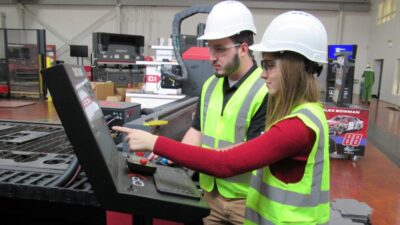A challenge for companies using automated woodcutting machinery is to help operators clear jams quickly without exposure to potentially hazardous machine motion. Simply opening up the machine to clear a jam runs the risk that stored electrical or hydraulic energy might cause the machine to move. On the other hand, performing a lockout/tagout operation to put the machine in a verifiably safe sta...
A challenge for companies using automated woodcutting machinery is to help operators clear jams quickly without exposure to potentially hazardous machine motion.
Simply opening up the machine to clear a jam runs the risk that stored electrical or hydraulic energy might cause the machine to move. On the other hand, performing a lockout/tagout operation to put the machine in a verifiably safe state takes a considerable amount of time. To develop a new guarding system, Hasko Machines in Soddy Daisy, TN, worked with Omron Machine Services, maker of machine and process safeguarding products based in Anaheim, CA. The result was a relay based system that automatically shuts down and locks out the Hasko FSM MatchMaster flooring machine in approximately 10 seconds, enabling quick clearing of jammed stock.
The Hasko FSM MatchMaster can produce more than 200,000 linear feet of tongue and groove hardwood flooring per shift. The machine features directly opposed sideheads, built in top and bottom jointers, a programmable logic controller (PLC) and electric motor breaking.
Periodically, it’s necessary for the operator to stop the machine and remove a jammed board, make a machine adjustment, or perform a similar task. So Hasko has developed a unique process for clearing a jam anywhere in the machine and resetting the machine to exact position in one minute or less.
The machine has a series of buttons that can be pushed to open guards on various parts for fast access. But even after the machine is powered down, there is the small chance that potential energy in the hydraulic or electrical power systems might expose the operator to hazardous motion. A typical lock out/tag out procedure involves turning off the power at the control panel and putting a padlock on the switch to prevent it from being turned on until work is completed. This procedure takes about 15 minutes—many times longer than clearing the actual jam.
Hasko determined that clearing out the machine falls under the OSHA lockout/tagout exception (OSHA 29 CFR 1910.147(a)(ii)(B)) that makes it possible to utilize alternative measures to provide a safeguard.
Meeting safety standards
Hasko set out to developed a machine control system that would maintain the speed of its quick-clear method while incorporating safeguards and circuits that meet the alternative measure standards as described in ANSI/ASSE Z244.1-2003, particularly clause 5.4.3.2 where levels of control circuit integrity are described.
“We decided to partner with Omron Machine Services on this project,” which provides products and system integration services, explains Wayne Abston, technical operations manager for Hasko. A zero speed sensor compatible with an inverter used to control the machine’s motor, says Abston, eliminating the need for external hardware such as motion detection sensors.”
Hasko and Omron Machine Services engineers worked together to develop a method for putting the machine in a safe mode within seconds so the operator could clear a jam in less than a minute. The new guarding system includes interlocked barrier guards using an Omron STI dual channel monitoring relay (model SR208AD). Three SR122E expansion modules provide dual channel monitoring of the six Omron STI locking interlock switches (model TL4019). Five Omron STI stop-motion SR125SMS monitoring relays are used, one for each motor drive. When the operator presses the stop signal, the monitoring relay detects the back electromagnetic force (EMF) of the motor and senses when motion has ceased.
Once the drives have decelerated the motors and stopped the cutter heads, the delayed outputs of the SR208AD relays are used to remove power from the cutter head drives. The relay then signals the guard locking switch to unlock the guard, allowing safe access to the machine.
Abston says this dual channel with monitoring circuit for locking interlocked barrier guards complies with ANSI B11.19 and ANSI/INFPA 79 for interlocked guards, where the hazardous motion can have excessive coast down time and the operator could reach the hazard prior to cessation of motion.
Depressurizing hydraulic system
The hydraulic circuit also employs an ANSI blocking solenoid valve that dumps pressure from the main supply manifold to the tank when it is not energized. This value has spool position monitoring wired into the safety circuit monitoring loop to ensure that the hydraulic feed motors and heads are isolated from hydraulic pressure during safety and emergency stops as required. According to Abston, hydraulic valve redundancy with monitoring of the coil position complies with the intent of ANSI B11.19 for single component failure for the hydraulic components that have direct control of point-of-operation hazards.
The emergency stop circuit includes an Omron STI dual channel monitoring relay model SR208AD that provides dual channel monitoring of all emergency stop pushbuttons. The circuit provides contacts from dual channel force guided relays that are monitored by the relay.
Contacts are then interfaced to the PLC. All PLC outputs are interrupted, with the exception of those that are necessary to allow for opening the machine feed rolls to clear jammed stock. Use of redundant monitored interlock circuits means that all single faults are detected in the safety control system, with no loss of the safety function, says Abston.
The new integrated safety system increases safety and production over existing machines, Abston says. Hasko is providing the new machine safeguarding as an option that costs approximately 5% of the total cost of the machine. The reduction in the time to clear jams—from more than 15 minutes to less than 1 minute—pays back the additional cost of the of the safety features in less than one year. The time to perform other common operations, such as checking the height of the bottom head, has been reduced by a similar amount, Abston adds.
Collaboration among the customer, system integrator, resulted in a “system that provides substantial improvements in both productivity and safety,” Abston concludes. “The new safety system has been so successful that we are incorporating its features into other machines, such as a new ripsaw that we have just developed. The new safety system gives us a considerable advantage over our competitors.”
Author Information
Mark Nehrkorn is the Safety Integration Division manager for Omron STI Machine Services.



